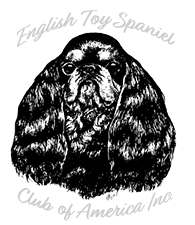Back to Basics: A Comparison of the English Toy Spaniel and the Cavalier King Charles Spaniel
By Cindy Huggins
Reprinted with permission from Dogs in Review and author Cindy Huggins, from the June 2015 issue of Dogs in Review magazine.
Many people are unable to recognize the difference between the English Toy Spaniel and the Cavalier King Charles Spaniel. They are two entirely different breeds and, apart from sharing the same coat colors, have totally separate breed standards and characteristics.
A Brief History
The Cavalier King Charles Spaniel as we know it today was not given official AKC recognition until 1996. [Prior to that time, the breed spent many years in the Miscellaneous Class and was also exhibited at shows put on by the Cavalier King Charles Spaniel Club, USA. CKCSC, USA breed shows continue to this day and many breeder-exhibitors show in both venues. — Eds.] The English Toy Spaniel, whose history has been documented since the 15th century, has its origins in the courts of Europe and gained official AKC recognition in 1886. In 2006 only 161 English Toy Spaniel litters were registered with the AKC, while the litter registration for Cavalier King Charles Spaniels exceeded 4,000.
The first written reference to the King Charles Spaniel was around 1570. Named after King Charles II, it was originally a small sporting spaniel with a long muzzle. In the 1800s, those spaniels were bred with an oriental short-nosed spaniel to produce the modern King Charles Spaniel known in America as the English Toy Spaniel. The longer-nosed King Charles Spaniel was given separate breed status in 1945.
What you must keep in mind when reading the Cavalier King Charles Spaniel standard is that it was written in a way to distinguish the difference between the English Toy Spaniel and the Cavalier King Charles Spaniel.
General Appearance
The English Toy Spaniel is a compact, cobby and essentially square toy dog, whereas the Cavalier King Charles Spaniel is a well-balanced toy spaniel. The Cavalier approaches squareness, yet if it is measured from point of shoulder to point of buttock, it is slightly longer than the height at the withers. The Cavalier King Charles Spaniel should demonstrate a gay temperament combined with true elegance and a look of royalty. He must have a natural appearance with no trimming, sculpting or artificial alteration of the dog or coat.
Size, Proportion and Substance
The English Toy’s desirable weight for an adult is 8 to 14 pounds. It is compact, square in shape, built on cobby lines and sturdy of frame, solidly constructed. The Cavalier’s desirable adult weight is 13 to 18 pounds. The Cavalier height is 12 to 13 inches at the withers with moderate bone in proportion to size.
Head, Muzzle and Mouth
The English Toy head is large in comparison to the size of the dog, with a plush, chubby look. The skull is high and well-domed, full over the eyes. The ears are very long, set low and close to the head. The English Toy’s eyes are large, very dark brown or black and set squarely in line with the nose.
The Cavalier head is proportionate to size of dog, appearing neither too large nor too small for the body. The skull is almost flat between the ears, and the ears are set high but not close on top of the head. The eyes are large, round and well set apart with dark rims.
The English Toy has a deep, well-defined stop, and the muzzle is very short with nose well laid back. This breed should have a slightly undershot bite with a square, broad, deep and well turned-up jaw. A wry mouth should be penalized.
The Cavalier stop is moderate, and the length of muzzle from base of stop to tip of nose is about 11/2 inches. The Cavalier has a perfect, regular scissors bite. An undershot bite, weak or crooked teeth or crooked jaw are faults in this breed.
